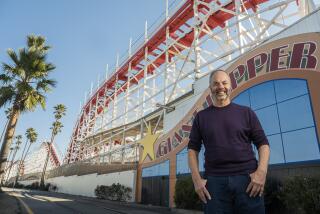Email newsletters connect advertisers with eager audiences
- Share via
Actor Rob Lowe is the face of InsideHook L.A., a free, curated email newsletter announcing special experiences to men too busy to find those experiences themselves.
The newsletter, which launched in Los Angeles last week, is the latest effort from capital investment firm Pilot Group, whose founders Bob Pittman and Andy Russell have also had a hand in shaping the successful email newsletters DailyCandy, Thrillist and Tasting Table.
Lowe spent a recent afternoon indulging in InsideHook-delivered experiences — hovering high above the ocean off Newport Beach using a water-propelled jet pack, guzzling organic juice from his favorite Santa Monica food truck and dining at Santa Monica’s new members-only club 41 Ocean.
PHOTOS: Celebrities by The Times
InsideHook and similar services send out daily emails highlighting such activities. They drive members of their very specific subscription bases — wealthy, connected men, or young urban women, or college-age thrill seekers — to a variety of restaurants, bars, shops and other businesses. And in many cases, delivering high-end highlights may also deliver huge dividends.
DailyCandy was sold to Comcast five years after its 2003 launch for $125 million and had close to 3 million subscribers. Thrillist has been valued by an outside investment source at $150 million, and Tasting Table has been valued at an estimated $50 million. The latter launched in 2008 and currently has 1.7 million subscribers in five cities.
Co-founder Russell said recently that InsideHook is the fastest-growing email newsletter that he has been a part of, and he feels the digital newsletter business is in no danger of slowing down.
“The difference between unique visitors to a website and someone who subscribes to your newsletter is night and day,” he said. “Because when a person reads your newsletter, it becomes a part of their daily routine. Audience engagement is much, much higher, and advertisers know this and are willing to pay for it.”
Subscribing to these newsletters is free. The profit is made purely from ads. Russell and others involved in the newsletters said that selling data is not part of the process, although they do mine their own data to make attractive pitches to would-be advertisers. For example, if 75% of their core audience has shown interest in purchasing a new car, they will let Audi or Fiat or Mini Cooper know — so those companies can advertise to a group that has expressed an inclination to buy.
“It all lent itself to something very viral, it was consumed and passed along as frequently as it was read,” said Pete Sheinbaum, a former DailyCandy chief executive. “We didn’t have to spend any money on marketing because our readers were our marketers.”
DailyCandy, InsideHook and other newsletters are written in short, 200-word blasts. Good editorial content is key, as is not sending subscribers to something that will turn out to be a big disappointment. A lot of time and effort is put into researching the places that the letters are telling people to go to. Russell says a good blast is like your best friend whispering a juicy secret in your ear. That’s how the letters maintain relevance.
“We don’t call ourselves an email newsletter, actually,” said Geoff Bartakovics, the CEO of Tasting Table, which caters to people who live and die for food and drink. “We’re an email-delivered publication — the equivalent of a magazine sending out one article at a time.”
This year, after conducting its annual consumer study, Tasting Table discovered that its biggest competitors were Bon Appetit and Food & Wine magazines, not other newsletters.
InsideHook CEO Jon Keidan agreed with that assessment and took it a step further.
“We have a niche audience, so we want to be the ultimate resource for them,” he said. “Our subscribers probably read GQ and Esquire, but those magazines can’t do it locally. We’ve got a lot more area covered.”
Lowe, as the face of InsideHook, is also representative of its target audience — successful, connected, wealthy men in their 40s and 50s. Over scones and snacks at 41 Ocean, he said the InsideHook business model is what drew him to the company.
“I immediately got the need and connection to a certain type of man,” he said. “Everything is getting so fragmented and specific these days. Soon the term ‘broadcast’ won’t exist anymore. It will all be ‘narrowcasting.’”
MORE
INTERACTIVE: TVs highest paid stars
ON LOCATION: People and places behind what’s onscreen
PHOTOS: Hollywood back lot moments
More to Read
From the Oscars to the Emmys.
Get the Envelope newsletter for exclusive awards season coverage, behind-the-scenes stories from the Envelope podcast and columnist Glenn Whipp’s must-read analysis.
You may occasionally receive promotional content from the Los Angeles Times.











